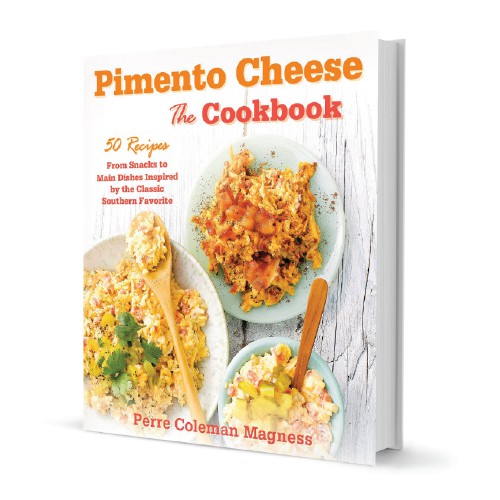
Join intern Virginia on her journey to discover how different regions of the US use local cheeses to improve local cuisine. From Vermont cheddar to Wisconsin colby and on to California Monterey jack, she’ll hit the iconic cheese destinations of America and introduce you to regional delicacies and recipes along the way. If you missed it, don’t forget to read last week’s post on Wisconsin Colby.
Have you recently visited your local Costco and been astonished to walk past pimento sushi? While casually flipping through dessert recipes, have you come across one for neon-orange pimento cheesecake? Has a restaurant in your area presented you with the option of pimento grilled cheese? If so, you are one of many to experience the wonderful renaissance of pimento cheese. Chefs and eaters all other the country have recently embraced the orange spread and have been thinking up new and creative ways to show off their new found love of Pimento Cheese.
History
It may surprise you to learn that pimento cheese was originally a luxury food item. According to Robert Moss of Serious Eats, pimento cheese materialized in the early 20th century in little tea sandwiches for the upper classes in the Carolinas. Because of the high price of cheese and the need to import the peppers, the cheesy spread was not an option for the masses until Kraft Cheese created its processed cheese in 1915. Southerners quickly realized that their local soil was good to grow pimento peppers and soon the cheese spread was open to everyone.
As time progressed pimento cheese became an easy staple for a factory worker’s meal. It was easy to assemble, easy to store, and delicious. In a day and age when workers were expected to work through lunch, pimento cheese was that perfect quick and accessible something to get them through the day.
In the 1930s and 40s, when men were often laid off from jobs or sent overseas during the war, women increasingly entered the workforce. Since one of the most marketable skills many women of this time had was cooking, they took their knowledge to the job market, and several restaurants and companies started selling pimento cheese as a variety of salad. Karlie Keith Fisher founded the Fisher brand in Raleigh, NC, in 1928, Jessie Thomas Buie opened the Biscoe Sandwich Shop in Biscoe, NC, in the 1940s, and Ruth Ross started Ruth’s Salads in Charlotte, NC, in the ’50s. Though these companies have either closed or moved operations overseas, pimento cheese is still immensely popular in North Carolina.
Interestingly, pimento cheese never lost its appeal for the upper classes and still remains a staple for Southern teas and ladies lunches, even though it was popularized by the working class.
Why It’s Back
I was fortunate enough to interview the Queen of Pimento Cheese, Emily Wallace, and asked her some questions about the spread that she calls a ubiquitous part of her life. Wallace chose to write her master’s thesis on Pimento Cheese and has since been a pimento and Duke’s mayonnaise advocate on her website.
For Wallace, what was once something that lived in her refrigerator for convenient sandwiches has now become a cross-cultural food item that has exploded over the food scene in the last few years. She is unsurprised. Not only is it versatile and delicious, it has strong roots in the working class culture of America and has lasted the test of time.
Recipes
Usually I like to tell you where you can find the best of the best in this blog post, but after talking to Wallace, it was apparent to me that the best place to find pimento cheese is in your own kitchen. She recommends making your own, which really isn’t hard to do. In her opinion, most store-bought versions are neon orange and goopy, which can be less than appealing. Making the spread at home is simple: you need only some good cheddar cheese, mayonnaise, and pimento peppers. Here is a great recipe for making your own. If you do insist on buying it instead of making it, in Wallace’s opinion Star Foods makes the best.

Photo Credit: Image courtesy of Dessert for Two.
Try this recipe for Pimento and Fried Pickle Sandwich.

Photo Credit: Image courtesy of J. Kenji López-Alt via Serious Eats.
Nothing could be easier than adding some Pimento Cheese to your next burger.

Photo Credit: Image courtesy of Buns in my Oven.
Pimento and Bacon Pizza. A match made in heaven.

Photo Credit: Image courtesy of James Ransom via Food52.
Last but certainly not least, try making a Pimento Cheese Grilled Cheese.
Cookbook

Coleman Magness just came out with a cookbook that will tell you everything you need to know about using Pimento Cheese.
Answer to Win!
This week’s question: Do you have a favorite pimento cheese recipe (for the cheese itself or to use it in a dish)? Post your answer in the comments section by Wednesday, November 5, 2014 for a chance to win a FREE issue of culture magazine! You must be located within the continental US to be eligible to win. Good luck!
Photo Credit: Featured image courtesy of Cook Au Vin



Ruth Ross was my Grandmother. I am her Grandson Darel Ross. Her and my Grandfather started Ruth’s Salads in 1947 in Charlotte N.C.. Sold it to the Miller family in the late 50’s.